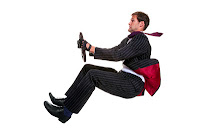Health effects of driving appear widespread
Most people suffer one or more problems when driving, according to an independent study in Britain. The findings are :
81% suffer from foot cramps
74% suffer from lumbar pain
74% have a stiff neck
74% have side aches, and
73% have a headache/eye strain (Adams 2006)
 |
| Notice locked elbows. What else? |
But what we do when driving is also part of the problem.
How we drive
The images in this blogpost suggest that pain is more likely in certain postures than others – specifically how we hold the steering wheel, and other places we hold unnecessary tension.
 |
| Cute, but gripping wheel, locking jaw and more! |
Driving gives you a real opportunity to explore what Alexander Technique is all about – increased awareness of our thinking and our bodies, inhibiting old habits, imagining and making alternative choices, and as a result, more effortless activity, and a sense of ease.
My suggestion to you
One way to work towards this is to play imaginary games – before and during driving. Scientific research shows how our thinking can bring about bodily changes (Schwartz & Begley 2003).
Here are two sets of ideas to think about as you drive. Start with those points that resonate with you, and come back to the others later. I will add ideas about the spine and legs in a later blog:
1. Fingers to shoulders
- Allow your fingers to ‘play’ softly on the steering wheel, and ask for your wrists to free,
- Allow the elbows to soften,
- Allow the shoulders to widen away from each other, and think of them resting gently on the rib cage as it moves with each breath.
2. Breathing
- Observe how your breath comes in and out of the large spaces behind the nostrils,
- Observe the ribs expanding front, sides and at the back where they rest on the seat,
- Ask for your jaw to soften, and release forward and down from near the earholes,
-
 |
| Minimal tension & using support well |
Will you remember to do this?
You will probably need a memory jogger if you are to choose a new way of driving each time you drive. So why not try the following:
After you buckle the seat belt, pause and remind yourself about these two sets of ideas. Consider repeating this when you turn on the ignition
Soon you will find that your thinking changes more and more as you drive.
Constructive rest
Why not include lying in semi-supine position in your driving plans? Do it before, during and after long trips. You can also practice all these tips while lying there. (See my blog post of 7 Dec 2011 ).
Sustain the practice
Making changes to your driving practices, and other daily habits, will require sustained effort. I wish you well. To speed up the process, consider a series of private lessons, my group classes, or discuss with me options for an activity in your workplace.
This is not medical advice. Consult your doctor if you are suffering a medical condition.
There are other good sources of ergonomic information on adjusting your seat, and buying a car.
References
Chris Adams (2006) Do You Suffer from Repetitive Driving Injuries? Driving Through the English Countryside in Pain (available online). Sample size of 1,000; survey conducted by independent researcher ICM for eBayMotors.
Cranz, G. (2000) The Alexander Technique in the world of design: posture and the common chair Part I: the chair as health hazard. Journal of Bodywork and Movement Therapies. Vol 4, Part 2, pp.90-98. (available on-line)
Owen, N., G.N. Healy, C.E. Matthews and D.W. Dunstan (2010). Too much sitting: the population health science of sedentary behavior. Exercise and Sport Sciences Reviews. Vol. 38, No. 3, pp. 105-113. (available on-line).
Schwartz, J.M. & S. Begley (2003) The Mind and the Brain : Neuroplasticity and the Power of Mental Force, Harper Collins, New York

2 comments:
Hi Jim,
Great post. I love the idea of allowing the fingers to play on the wheel while asking for my wrists to be free.
I have recently been exploring "negative or inhibitory directions" first put forth by Missy Vineyard. One morning in some particularly grueling Washington DC traffic the direction "I am not driving" arrived. Playing with this lightly over time has introduced ease and freedom while "stuck" behind the wheel.
These small moments can and do add up.
That's great Patrick. I reckon many people reading this post will find it useful to add "I am not driving" to their repertoire as well. Jim
Post a Comment